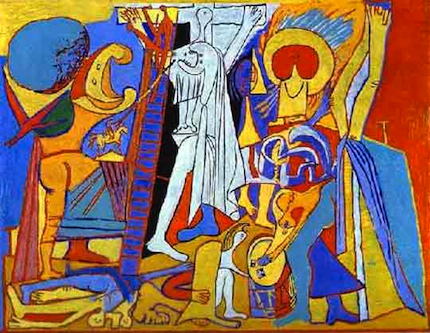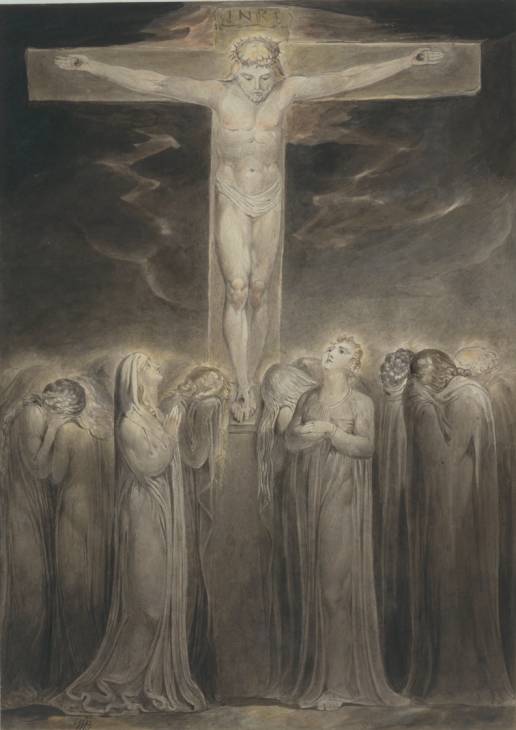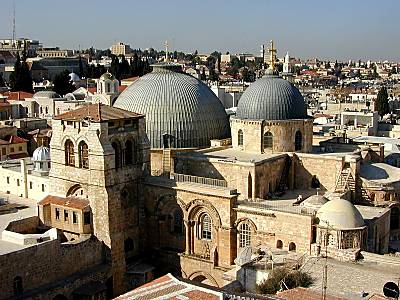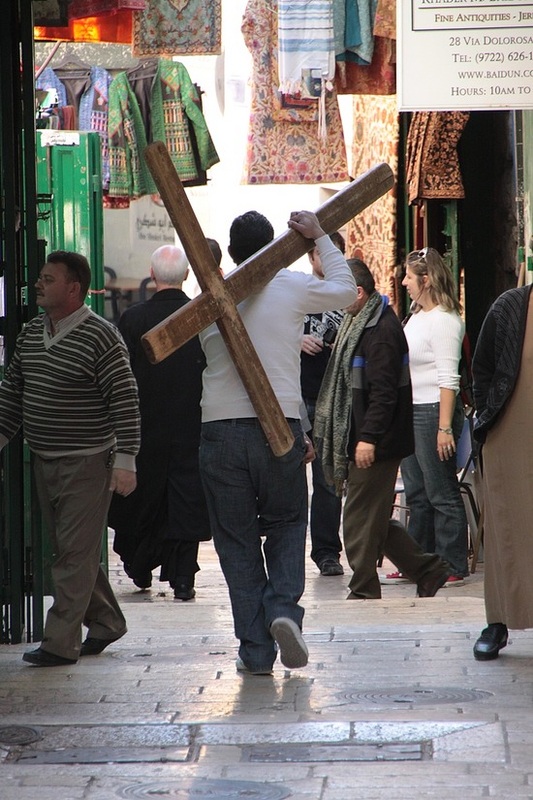Part I
In the final chapter of A Hitchhiker’s Guide to Jesus, Norm returns to the Mount of Olives to reenact Jesus’ final night with his disciples. In Gethsemane, Norm studies up on Jesus’ death and resurrection. He mentions the points of through multiple attestations and the criterion of embarrassment; this is where it is believed that Jesus and his disciples prayed before Jesus’ arrest (231). Martyrdom then becomes a topic of thought throughout the different interpretations of Jesus’ death in the Gospels. Two questions spark Norm’s thought: Why did the religious leaders want Jesus dead and why did the Roman government sentence him to death? (240) In conclusion, Norm receives the news about his mother’s cancer returning, and decides that his trip has come to an end (257).
Part II
The last chapter of the book finally addresses the topic of Jesus’ death, which is very interesting to Norm. He tries to figure out information about his death from what is expressed in the Gospels. I thought it was very cool that Norm practically walked in the steps of Jesus to try and figure out what actually happened. At the end of the chapter, Norm explains that there are always going to differences in how Jesus is viewed. Jesus can be viewed historically, or he can be viewed at the standpoint of a Christian. There are differences, but Norm notes that it is important to understand the historical Jesus in order to really know Jesus as he is interpreted in the Gospels.
Part 1
Norm begins the chapter at the Mount of Olives. There has just been a terrorist attack. Norm then goes into a cave where it is thought Jesus may have spent his last night. Norm then discusses the topic of martyrs and describes Jesus as a martyr of his time. Unlike the Maccabees though, Jesus accepted his death but did not seek it (Fisk, p.239). Fisk then goes on to tell why Jesus offended so many Jewish people. Many of them thought he was a false prophet, and they tried to stop his popularity from growing any further. Norm then goes on to discuss Jesus’ death and resurrection.
Part 2
One thing that interested me in this chapter was the parallel between Jesus and David on the Mount of Olives. Both 2 Samuel and the gospels describe a grieving king in Gethsemane, asks God to remove his humiliation and restore him to the throne (Fisk, p.232). I had never heard this story of David before. It is really beginning to dawn on me just how many parallels there are between Jesus in the New Testament and the important people of the Hebrew Bible. It was also nice to see the criterion of embarrassment and multiple attestation in action in this chapter. The criterion of embarrassment applies to the fact that Jesus’ disciples are portrayed as uninterested and even fall asleep in the final hours of Jesus’ life. Jesus is also depicted as fearful of death and frail (Fisk, p.231). Multiple attestation is applicable because all the gospels tell of Jesus being on a hillside at the Mount of Olives.
Part I
In the final chapter of A Hitchhiker’s Guide to Jesus, Norm turns his journey to the death of Jesus. He begins by making his way towards Gethsemane, where Jesus was prior to being arrested, a scene that Norm attests must be historical because it is
represented in all four Gospels (230-234). Norm looks at the different interpretations of Jesus in the Gospels and his representation as a martyr of death (234-240). Two questions sit on Norms mind: Why did the religious leaders want Jesus dead and why did the government sentence him to death? (240) Norm concludes that it was because Jesus spoke up against the temple and was a deceiver in certain ways (240-243). Norm then follows a tour group as they make a path through the Old City, similar to the one that Jesus walked when he carried his cross (248-257). In the conclusion of Norms trip, he receives news about his mother’s cancer returning and decides that it is time for him to go home (257).
Part II
This chapter seems very ominous, not only because it is the last chapter of the book, but also because Norm has finally approached the topic of the death of Jesus. In this chapter, Norm tries to find things that both note and denote the information that is expressed about Jesus’s death in the Gospels. I really appreciate the approach that Fisk used in this chapter, where instead of disproving what was written, he looked for confirmation. I feel like that is part of the reason that the character Norm had to walk in the footsteps of Jesus because this is one of the most memorable parts of both of their journeys. One thing that I find important to note is that while Norm is reflecting on his journey as he is on his way home, he implies that the most important things about Jesus, are the things that people choose to see as important. In terms of his journey, this meant that he was not looking for the historical Jesus so that he could disprove or reaffirm the Gospels, but rather because it was important for him to learn about the historical Jesus.
Part I
The seventh and final chapter of A Hitchhikers Guide to Jesus starts off with Norm in Gethsemane to study Jesus’ death and resurrection. On page 231, Norm mentions the two ideas of multiple attestation and criterion of embarrassment that confirm for him that “something memorable happened that night.” It is there where Jesus and his disciples prayed prior to his arrest. Something that stood out to me in the chapter was when Norm mentions on page 236 that Jesus’ prayers sound more like a plea for rescue than to change the divine mind. Norm defines martyrdom and compares it to Jesus and what he died for and states that Jesus’ death qualifies (239). The tomb and Jesus’ absence is one of the final themes brought up in the chapter. Norm mentions how the disciples could have seen the empty tomb and taken it for the resurrection of Jesus.
Part II
In the middle of 240, Norm asks two questions that he looks to answer in the chapter. Why did the religious leaders want Jesus dead? and why did the Roman government sentence him to death? It is pretty simple to me that Jesus posed a threat to the other religious leaders and what they stood for. Norm states that the Roman government wanted Jesus dead for similar reasons. Norm states that crucifixion was as shameful as it was painful however; there is debate for how Jesus was actually crucified. The tomb being empty was another main theme that I questioned along with Norm. Norm compares the difference in stories between the gospels and concludes that at the very least, the images of the tomb people think of and can see are merely a recreation of the original tomb. One of the last things Norm mentions is how there will always be difference in opinion between historical followers of Jesus, and Christian followers of Jesus.
Part I
In the final chapter of AHitchhiker’s Guide to Jesus, the main focus is on Jesus’ crucifixion and resurrection. The final chapter begins with norm returning to the Mount of Olives to relive Jesus’ final night with his disciples. Here Norm brings up the points of multiple attestation and embarrassment (231). He again brings up the fact that the gospels had to be drawing on historical memory when Jesus went to the hillside to pray. Also, early Christians wouldn’t want to invent a scene where it makes it look like Jesus’ disciples would have dozed off during his greatest hour of need. I found the part about the tomb the most interesting during this chapter.
Part II
Norm is comparing Jesus to a second David. He compares David’s grieving and asking God to remove his humiliation and to restore him to the throne (234) to Jesus asking him to remove the cup from him (236). That was interesting because it makes Jesus look like he’s terrified about his death where I always have pictured Jesus being calm about things and not having second thoughts about his death. Did Jesus want to become a king without struggle or death (237)? Norm also parallels Polycarp’s story to Jesus’ (238). God tells both how they will die, that they will be betrayed, they were both found in large upper rooms, and they both refuse to escape and say “God’s will be done” (238). These were just a few of the parallels that Norm uses. Polycarp was eager to die and believed that one innocent victim could save many (238). So with that being said, he was also like Jesus in that he believed with the death of one person many could in return be saved. There were tons of other stuff that I liked about this chapter, but one last thing I liked and that I’ve never heard talked about was how Jesus’ body may have been removed from his tomb and taken to another one. Could this be true? Instead of Jesus being resurrected could his body just have been moved? Through all of Norm’s travels he discovers that the Man who traversed the land and the One who strides in the Gospels has many faces.
Part I
The final chapter in A Hitchhiker’s Guide to Jesus is about finding the history within the death and resurrection of Jesus. The first place Norm stops on this journey is in Gethsemane; which is where, through multiple attestations and the criterion of embarrassment; it is believed that Jesus and his disciples came to pray prior to Jesus’ arrest. Norm then evaluates the Gethsemane event within the gospels and compares his findings to the definition of martyrdom. Norm delves into the history of Jesus’hearing before Pilate, and questions what the allegations against Jesus actually where and why Pilate’s final verdict was crucifixion. Next Norm finds himself following the Via Dolorosa, which Jesus followed on his sorrowful journey from Pilate’s tribunal to the cross to the grave. At the end of the chapter Norm finds himself questioning whether disciples mistook the emptiness of the tomb for resurrection.
Part II
I found two questions that Norm poses very interesting: 1) why did the religious leaders want Jesus dead? 2) Why did the Roman government sentence him to death (240)? Norm also brings up a repeated theme found throughout this book; that every historical account is someone’s and that every story has a teller, neither of which announce when they switch between history and embellishment (249-250). Another aspect in this chapter that I found fascinating was one that Norm brought up about how there are no descriptions or details about Jesus’ crucifixion, you would think that the readers would take something this important to Christianity and explain it symbolically (251-255). One of the final points that Norm experiences is how being a historical scholar versus a Christian follower can skew your views about artifacts and their possibilities (261-267).
Part I
The final chapter of A Hitchhiker’s Guide to Jesus, Norm concentrates on the crucifixion and resurrection of Jesus. Norm begins the final leg of his journey at a place known as Gethsemane, the hillside where Jesus and his disciples are said to have prayed before Jesus’ arrest (231). Norm goes on to decipher the differences between each Gospel on these final events of Jesus’ life. When Norm comes to the stories about the crucifixion event, he declares that the Gospels simply state: “they crucified him” (252). There were no reports of gory details as are seen through tales of this event today. Norm explores an interesting theory about Jesus’ resurrection, or more simply put: his absence in the tomb upon Mary’s visit. This idea states that Jesus was absent from his tomb because he was moved to another site, possibly a family tomb, rather than being brought back to life (260). Norm’s journey ends in a less than satisfactory way, as he was unable to make accurate conclusions about the historical Jesus other than the fact that he has many faces and serves many roles (266).
Part II
The family tomb theory that Norm explores is stated to contain too many problems to be held true. This theory states that Jesus had a son named Judah and was married to Mary Magdalen (loosely translated from the name Mariamene). These ideas however do not contain historical evidence (260). Another theory that Norm criticizes is that of the temporary burial. Norm states that this theory cannot explain the widespread belief that Jesus was resurrected from his tomb because no one had expected to find an empty tomb and were genuinely surprised when they had (264). When Norm finally visits the place where jesus’ tomb used to be, he concludes that the, just like the story, this remade tomb was built on belief rather than fact: “Everywhere I looked tradition. Nowhere history” (264). This quote by Norm sums up his journey justly, in that there is no real way to find the historical Jesus because every aspect of his life is built upon tradition and interpretation.








 RSS Feed
RSS Feed